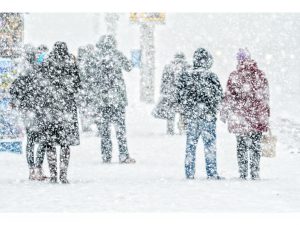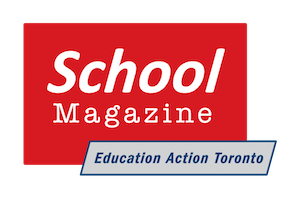The pain isn’t only about education cuts
Public education is not a priority of the Ford government and School Magazine has devoted a lot of pixels to explaining what that means. Think about increases to class sizes, teacher lay-offs, loss of available courses, cuts to programs for students on the autism spectrum, question marks hanging over the future of kindergarten, the repair backlog – the list goes on and on. If ever there was a government preparing to eviscerate a central public good, this is it.
Unfortunately, there’s more to the story. That is what’s becoming clearer as people take a closer look at the 2019 Ontario Budget of Doug Ford. Like anything else, education relies on the conditions around it: the health of the families whose children attend schools, their ability to pay bills, to house themselves and so much more. That list goes on too.
So, what about some of Mr. Ford’s other plans? How do they affect our students?
Cutting the Legal Aid Ontario budget by $133 million
This is almost one third of its budget. According to Queen’s Park Briefing, Legal Aid Ontario can’t fund refugee appeal cases anymore. CEO David Field told his staff that he’d been instructed by the Ontario government to only use money from the federal government to handle refugee and immigration cases. Consider the financial stress alone this will put on vulnerable families across the province seeking help to stay in the country or trying to defend themselves or relatives from charges. The Canadian Association of Refugee Lawyers said in a statement that “the unilateral and abrupt end to this critical legal services funding will put people’s lives at risk.” Those lives affect the school children in them who now will face an additional hurdle to pay attention in Mr. Ford’s larger classes.
Cutting revenue sharing from gasoline taxes
 The same government that wants to “upload” Toronto’s subway because it claims it can do a better job of running it, plans to cut $1.1 billion over the next decade from its share of the gasoline tax. Just in the coming year, $24 million of that money had been earmarked by Toronto to keep buses running. It’s another shot to the thousands of people who rely on transit to get to work, get their kids to appointments, activities and so on. Good transit is vital to schools – not just because it gets kids to them, but because it allows families to get where they need to go quickly, so they can spend more time together.
The same government that wants to “upload” Toronto’s subway because it claims it can do a better job of running it, plans to cut $1.1 billion over the next decade from its share of the gasoline tax. Just in the coming year, $24 million of that money had been earmarked by Toronto to keep buses running. It’s another shot to the thousands of people who rely on transit to get to work, get their kids to appointments, activities and so on. Good transit is vital to schools – not just because it gets kids to them, but because it allows families to get where they need to go quickly, so they can spend more time together.
No money for Toronto housing
There was no mention of dollars for improving the shortage of affordable housing here, where the waiting list now is 15 000 and growing. Finance Minister Vic Fedeli mentioned plans to make it easier to build rental housing and provide more affordable housing but didn’t attach any money to them. Fortunately, Toronto has a bit better relationship with the federal government which has injected $1.3 billion to fix nearly 60 000 of our crumbling social housing units. What is more basic to a child’s ability to embrace education than a reliable and safe place to live?
The answer to that question: food and water
The Ford government plans to replace 35 local health units with 10 regional ones and cut their budgets by $200 million. As far as Toronto is concerned, the province plans to cut funding from 100 percent on some services to 50 percent on others by 2021. The local health units hire the people who inspect restaurants, test water quality, provide vaccinations and guard against infectious diseases. School immunization programs will be affected.
Remember Walkerton? That was the tragedy in 2000, the Harris conservatives might have helped to prevent, according to an inquiry led by Justice Denis O’Connor. Instead it chose to cut environmental funding. The town of Walkerton’s drinking water wasn’t properly monitored and 7 people died from the resulting e-coli outbreak.
Back home, Toronto Public Health helps to fund the Student Nutrition program which provides a healthy snack each day for 208 000 students across the city. Kids learn about healthy alternatives to candy bars, but if this program is cut back, where will the $14 million come from that keeps it floating? As Toronto Catholic District School Board chair, Maria Rizzo told School Magazine, “you would never take food away from a child” as she explained how the snack program gives students a healthy boost when they need it. After all, she added, “you can’t learn on an empty stomach.”
Cutting the Indigenous Affairs Ministry
There’s some dispute over whether Mr. Ford cut this budget in half if you count land claims settlements from last year or not. The fact is the budget was $88 million in 2017-18 and now it’s $74.4 million, so it’s looking like a 15 percent cut, at least. Indigenous Affairs has already been cut $20 million by this government. It now has even less to settle land claims, enhance awareness of Indigenous peoples’ issues and help them gain access to services that its website promotes. The Ministry of Education already put a stop to the Indigenous peoples’ curriculum writing team last summer. Truth and reconciliation is certainly not a priority with this government.
Cutting nearly $1 billion from Children Community and Social Services
Over the next 3 years, spending will drop from the current $17 billion to $16 billion. The government says moving more people from welfare into work will save $720 million over those 3 years – though it isn’t explaining how it plans to accomplish this.
Social assistance currently supports about 1 million Ontarians. The Liberal government planned a 3 percent hike in payments, but the Tories cut that back to 1.5 per cent. They’ll allow welfare recipients to earn up to $300 per month before they claw back 75 percent of their earnings – not much incentive to work. The Ministry also has a new definition of disability that makes it more difficult for people with periodic illness and mental health issues to apply for support.
Let’s get this straight – a ministry that deals with the welfare of vulnerable children and families is making serious cuts to their ability to manage in a very competitive world. Of course, children in those families aren’t going to be able to buckle down and try harder in their classrooms.
Getting rid of the Criminal Injuries Compensation Board and cutting the maximum payment an injured person can receive from $25 000 to $5 000 for pain and suffering
Victims of crimes can get coverage up to $30 000 for therapy, lost wages and funeral expenses. But that cut for pain and suffering on the backs of some of the poorest and most vulnerable people among us, saves only about $13 million dollars. For children in families who have experienced violence and trauma and have few options to deal with it, it’s another nail in the coffin of their chances at school.
Cutting provincial library services by 50 percent
These are the services that support local libraries across the province. They offer training and support for local librarians, handle interlibrary loans and deliver books across the province. Doug Ford doesn’t like libraries much, voting to cut $4 million from local libraries when he was Toronto councillor and adding that he would close local libraries “in a heartbeat.” This is yet another hit to local services that support schools. Students go to libraries for the programs on offer, to research projects, to wait for parents, brothers and sisters after school and of course, to read, take out books and videos. How does a government on one hand say it’s going to make education better across the province when it makes it harder for libraries to operate?
Good schools and their communities
Good schools don’t run independently from the communities around them. They interact with them through transit, public health, libraries, services for vulnerable people, courts, police – even roads and lighting. It’s simple: a child will not manage in school who worries whether or not her parents are going to have enough to pay for housing or put food on the table. It’s even worse when the nutrition program at her school is cut back. It’s worse still when her family has to spend more time getting home from work. It’s disastrous when all those hurdles come together. If you look at each of these Ford government cuts, it’s easy to see how they hurt people who don’t have the money or influence to get out from under them- people who can’t move somewhere else, who can’t just leave the country or hire someone to help them with a problem that would be to be too much to handle on their own.
But as a whole, these cuts are like dropping a pile of bricks on those who are struggling to get by as well people who, like all of us, just need government services. Maybe this is the Ford government’s idea of promoting “resiliency.” If so, it’s a nasty and cynical one, calculated to make Ontario a place to grow only “for the people” who can manage without the services provided by good government.

